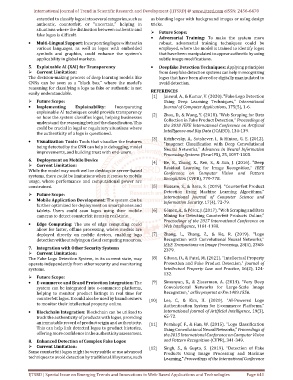Page 651 - Emerging Trends and Innovations in Web-Based Applications and Technologies
P. 651
International Journal of Trend in Scientific Research and Development (IJTSRD) @ www.ijtsrd.com eISSN: 2456-6470
extended to classify logos into several categories, such as as blending logos with background images or using design
authentic, counterfeit, or "uncertain," helping in tricks.
situations where the distinction between authentic and Future Scope:
fake logos is difficult.
· Adversarial Training: To make the system more
· Multi-Lingual Support: Incorporating logos with text in robust, adversarial training techniques could be
various languages, as well as logos with embedded employed, where the model is trained to identify logos
symbols and graphics, could enhance the system’s that have been manipulated to appear authentic by using
applicability in global markets. subtle image modifications.
5. Explainable AI (XAI) for Transparency · Deepfake Detection Techniques: Applying principles
Current Limitation: from deepfake detection systems can help in recognizing
The decision-making process of deep learning models like logos that have been altered or digitally manipulated to
CNNs can be seen as a "black box," where the model’s avoid detection.
reasoning for classifying a logo as fake or authentic is not
REFERENCES
easily understandable.
[1] Jaiswal, A., & Kumar, V. (2020). "Fake Logo Detection
Future Scope: Using Deep Learning Techniques," International
· Implementing Explainability: Incorporating Journal of Computer Applications, 175(5), 1-6.
explainable AI techniques could provide transparency [2] Zhou, D., & Wang, Y. (2018). "Web Scraping for Data
on how the system classifies logos, helping businesses Collection in Fake Product Detection," Proceedings of
understand the reasoning behind the classification. This the 2018 IEEE International Conference on Artificial
could be crucial in legal or regulatory situations where
the authenticity of a logo is questioned. Intelligence and Big Data (ICAIBD), 134-139.
[3] Krizhevsky, A., Sutskever, I., & Hinton, G. E. (2012).
· Visualization Tools: Tools that visualize the features
"Imagenet Classification with Deep Convolutional
being detected by the CNN can help in debugging, model
Neural Networks," Advances in Neural Information
improvements, and building trust with end-users.
Processing Systems (NeurIPS), 25, 1097-1105.
6. Deployment on Mobile Device [4] He, K., Zhang, X., Ren, S., & Sun, J. (2016). "Deep
Current Limitation: Residual Learning for Image Recognition," IEEE
While the model may work well on desktop or server-based Conference on Computer Vision and Pattern
systems, there could be limitations when it comes to mobile Recognition (CVPR), 770-778.
usage, where performance and computational power are
constrained. [5] Hussain, S., & Raza, S. (2019). "Counterfeit Product
Detection Using Machine Learning Algorithms,"
Future Scope:
· Mobile Application Development: The system can be International Journal of Computer Science and
further optimized for deployment on smartphones and Information Security, 17(4), 72-79.
tablets. Users could scan logos using their mobile [6] Gómez, A., & Pérez, J. (2017). "Web Scraping and Data
cameras to detect counterfeit items in real-time. Mining for Detecting Counterfeit Products Online,"
Proceedings of the 2017 International Conference on
· Edge Computing: The use of edge computing could
Web Intelligence, 1181-1188.
allow for faster, offline processing, where models are
deployed directly on mobile devices, enabling logo [7] Zhang, L., Zhang, Z., & He, R. (2019). "Logo
detection without relying on cloud computing resources. Recognition with Convolutional Neural Networks,"
IEEE Transactions on Image Processing, 28(4), 2368-
7. Integration with Other Security Systems 2379.
Current Limitation:
The Fake Logo Detection System, in its current state, may [8] Gibson, D., & Patel, M. (2021). "Intellectual Property
operate independently from other security and monitoring Protection and Fake Product Detection," Journal of
systems. Intellectual Property Law and Practice, 16(2), 124-
132.
Future Scope:
· E-commerce and Brand Protection Integration: The [9] Simonyan, K., & Zisserman, A. (2014). "Very Deep
system can be integrated into e-commerce platforms, Convolutional Networks for Large-Scale Image
helping to monitor product listings in real time for Recognition," arXiv preprint arXiv:1409.1556.
counterfeit logos. It could also be used by brand owners [10] Lee, C., & Kim, H. (2020). "AI-Powered Logo
to monitor their intellectual property online.
Authentication System for E-commerce Platforms,"
· Blockchain Integration: Blockchain can be utilized to International Journal of Artificial Intelligence, 19(3),
track the authenticity of products with logos, providing 65-72.
an immutable record of product origin and authenticity. [11] Pernkopf, F., & Han, W. (2015). "Logo Classification
This can help link detected logos to product histories, Using Convolutional Neural Networks," Proceedings of
offering more confidence in the authenticity assessment. the 2015 International Conference on Computer Vision
8. Enhanced Detection of Complex Fake Logos and Pattern Recognition (CVPR), 341-349.
Current Limitation: [12] Singh, S., & Gupta, S. (2019). "Detection of Fake
Some counterfeit logos might be very subtle or use advanced
Products Using Image Processing and Machine
techniques to avoid detection by traditional AI systems, such
Learning," Proceedings of the International Conference
IJTSRD | Special Issue on Emerging Trends and Innovations in Web-Based Applications and Technologies Page 641

